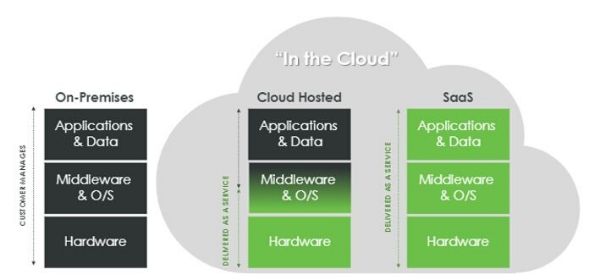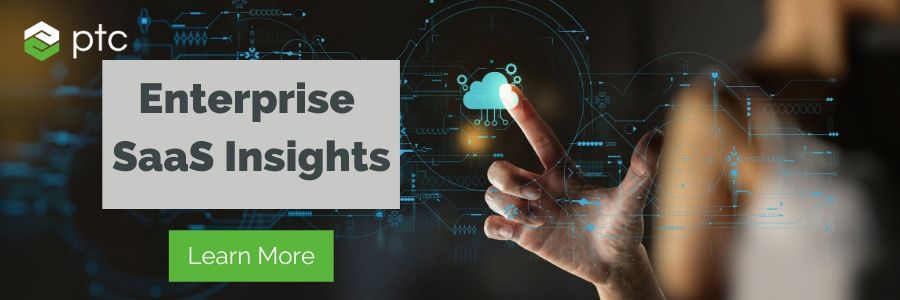What Is SaaS? A Guide to Licensing Models, Deployment, and Architecture
Software as a service (SaaS) is a type of software that is only licensed by subscription and only deployed in the cloud. The applications are diverse; enterprises have customer relationship management (CRM), electronic resources planning (ERP), computer-aided design (CAD), or augmented reality (AR), while at home, it's a part of daily life with applications like Netflix, Spotify, Gmail, and DropBox.
It's not necessary to understand SaaS to recognize its benefits. However, a better understanding of the technology helps illustrate why many of those benefits can only be delivered through a SaaS solution. All SaaS solutions have three things in common:
- Licensing model: customers pay on a subscription or consumption basis
- Deployment: the software is owned, delivered and managed in the cloud by a third party
- Architecture: one set of common code and data definitions is consumed in a one-to-many model
In this article we will explore the value of subscription licensing, how SaaS deployment differs from on-premises and cloud-hosted solutions, the new types of software architectures that SaaS enables, and how the combination of deployment and architecture provide transformational benefits.
Licensing: Perpetual vs. Subscription
With subscription you access software licenses in a pay-as-you-go model, rather than purchasing the software via one large upfront cost. Since the customer can cancel after short term contracts the vendor is more committed to customer success, and subscription models lower upfront costs and provide predictable budgeting for businesses.
The software industry has been ahead of the broader trend towards subscription because their products are natively digital and increasingly connected. In fact, research firm Gartner found that by 2020, more than 80 percent of software vendors will change their business model from traditional license and maintenance to subscription.
Deployments: On-Premises vs. Cloud Hosted vs. SaaS
Second, we’ll look at three general categories of deployment, shown below: On-premises, cloud hosted, and SaaS.
On-Premises
On-premises is the classic deployment model that has been used since the creation of software. With on-premises solutions, the hardware and the software users are co-located. The customer of an on-premises solution is responsible for managing the hardware, the operating system that sits on top of it, and managing the software application in question – this includes tasks like installing, updating, and upgrading.
Cloud Hosted
At a minimum, a cloud hosted deployment requires that the hardware be managed by a third party – this is often referred to as infrastructure as a service (IaaS). Cloud hosted deployments can come in many flavors depending on how much additional services are provided. For example, the term platform as a service (PaaS) implies that the middleware and operating system are also managed by the vendor.
SaaS
With SaaS all the resources and effort required to ensure the hardware, middleware, and application are up-to-date and operating efficiently is managed by the vendor as a service. By itself the SaaS deployment model provides some incremental benefits in terms of cost, ease of use, and go-live agility. More importantly, this deployment enables new software architectures, which can deliver transformation benefits to the customer.
SaaS-Enabled Architectures
Multi-Tenancy
Many of the benefits SaaS are enabled by multi-tenant architectures. With a multi-tenant architecture all SaaS customers use the same version of the software and share a common hardware infrastructure to execute their computing tasks. Despite being on the same software version and utilizing the same hardware environment, each instance, or tenant, in a multi-tenant architecture is logically isolated from the rest. This means that individual customer data is secure and that customers can manage things like user provisioning and software configuration to meet their needs.
Non-Relational Databases
Another technology that is often employed in SaaS solutions is the non-relational database. With a traditional data management system, a file can only be edited by a single user at a time. Conversely, with a non-relational database, multiple users can make edits to documents and data concurrently. In CAD applications, for example, this means that engineers can work on the same design in parallel. Any edit made by one user is seen by all users simultaneously, enabling new opportunities for collaboration and innovation.
The Unmatched Benefits of SaaS
The combination of the SaaS deployment model and SaaS enabled architectures provide users with a myriad of benefits that are unmatched by other deployments and can be organized into three categories:
Collaboration
By virtue of its deployment, all SaaS functionality is in the cloud, meaning teams can access applications and data from anywhere with any device. Users can be local or distributed, and highly mobile while continuing to execute tasks quickly and efficiently. Combining this mobility with the simultaneous editing of a non-relational database enables unparalleled collaborative capabilities.
Innovation Velocity
The multi-tenant architecture of SaaS solutions means the software and hardware is ready when you are, with no installation. The same underlying technology also makes it easy to quickly scale to meet the fluctuating needs of your organization. Further, because all customers are on the same version of the software, SaaS vendors can focus their resources to increase the value and frequency of updates that benefit all users. As a result, users of SaaS software see faster time to value and always have access to the latest and greatest capabilities the vendor has to offer.
Total Cost of Ownership
By consolidating the costs of maintenance, hardware infrastructure, and IT overhead across all end-users, SaaS vendors can leverage vast economies of scale to deliver a better software experience at a lower total cost of ownership.
SaaS Adoption Across Enterprise Software Markets
SaaS options may be new to industrial organizations, but the technology has been around for nearly two decades. Over the past decade SaaS has been widely adopted in enterprise software markets starting in areas where the challenge of integrating core application functionality with SaaS architectures was easiest to overcome.
As a result, today SaaS represents over 80 percent of customer relationship management (CRM), over 70 percent of human capital management (HCM), and nearly half of enterprise resource planning (ERP) software deployments by revenue. SaaS adoption accelerated in these markets once an option was available that managed to compete with established solutions on traditional functionality while also introducing the SaaS enabled benefits described above.

